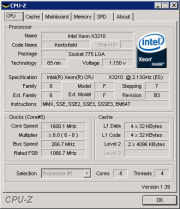Testování hardwaru pro firmu Intel
(→QuadCore Server configuration) |
|||
| (Není zobrazeno 60 mezilehlých verzí od 5 uživatelů.) | |||
| Řádka 1: | Řádka 1: | ||
| − | = | + | == QuadCore Xeon E5320 == |
| − | + | [[Soubor:Cpu-Z Clovertown.PNG|thumb|right|CPU-Z]] | |
| + | * OS: Microsoft Windows Server R2 2003 x64, Enterprise Edition | ||
| + | * OS: Debian x64 | ||
| − | |||
| − | + | * CPU 2x QuadCore Intel Xeon E5320, 1866 MHz (7 x 267) | |
| + | * Motherboard [http://www.supermicro.com/products/motherboard/Xeon1333/5000P/X7DB8.cfm Supermicro X7DB8](3 PCI-E x8, 3 PCI-X, 1 SEPC, 8 FB-DIMM, Video, Dual Gigabit LAN, SCSI), Chipset Intel Blackford 5000P | ||
| + | * 8GB RAM ECC DDR2-667 (333 MHz) | ||
| + | * 3x HDD Seagate [http://www.seagate.com/cda/products/discsales/marketing/detail/0,1596,650,00.html ST373207LC], 73GB, 10k, Ultra320 SCSI | ||
| + | * [http://www.wdc.com/en/products/Products.asp?DriveID=138 WD Caviar SE 120GB] | ||
| − | |||
| − | + | == DualCore Xeon E5150 == | |
| − | + | ||
| − | + | ||
| − | *CPU 2x | + | * OS: Debian x64 |
| − | *Motherboard [http://www.supermicro.com/products/motherboard/Xeon1333/5000P/X7DB8.cfm Supermicro X7DB8](3 PCI-E x8, 3 PCI-X, 1 SEPC, 8 FB-DIMM, Video, Dual Gigabit LAN, SCSI), Chipset Intel Blackford 5000P | + | |
| − | *8GB RAM ECC DDR2-667 (333 MHz) | + | * CPU 2x [http://processorfinder.intel.com/details.aspx?sSpec=SL9RU DualCore Xeon E5150], 2,66GHz |
| − | + | * Motherboard [http://www.supermicro.com/products/motherboard/Xeon1333/5000P/X7DB8.cfm Supermicro X7DB8](3 PCI-E x8, 3 PCI-X, 1 SEPC, 8 FB-DIMM, Video, Dual Gigabit LAN, SCSI), Chipset Intel Blackford 5000P | |
| + | * 8GB RAM ECC DDR2-667 (333 MHz) | ||
* [http://www.wdc.com/en/products/Products.asp?DriveID=138 WD Caviar SE 120GB] | * [http://www.wdc.com/en/products/Products.asp?DriveID=138 WD Caviar SE 120GB] | ||
| − | == | + | == QuadCore Xeon X3210 == |
| + | [[Soubor:Braccia2.PNG|thumb|right|CPU-Z]] | ||
| + | * OS: Debian x64 | ||
| + | * OS: Microsoft Windows Server R2 2003 x64, Enterprise Edition | ||
| + | |||
| + | * CPU [http://processorfinder.intel.com/details.aspx?sspec=sl9uq QuadCore Xeon X3210] | ||
| + | * Motherboard [http://www.tyan.com/product_board_detail.aspx?pid=349 Tyan S5197] | ||
| + | * 2GB RAM DDR2-667 (333 MHz) | ||
| + | * [http://www.seagate.com/ww/v/index.jsp?vgnextoid=d1ae99f4fa74c010VgnVCM100000dd04090aRCRD&locale=en-US Seagate Barracuda 7200.9 SATA 300-GB Hard Drive] | ||
| + | |||
| + | ==[[Synthetic tests E5320|Synthetic tests]] == | ||
| + | |||
| + | Some screenshots from SiSoftware Sandra | ||
| − | |||
| − | |||
| − | == | + | ==[[VUCAKO results|Task-oriented benchmark results]] == |
| − | + | ||
| − | + | ||
| + | Results of task-oriented benchmark suite [http://cgg.ms.mff.cuni.cz/~pepca/bench/ VUCAKO Bench]. | ||
| − | |||
| − | |||
| − | |||
| − | |||
| + | ==[[BRACCIA project | BRACCIA project]]== | ||
| − | + | The project BRACCIA (Brain, Respiration And Cardiac Causalities In Anaesthesia) is a part of the 6th Research Framework program of the Europian Union (NEST: New and Emerging Science and Technology ). The goal of the project is to uncover the complex interactions between brain waves, heart and respiratory rhythms and how these change during anaesthesia. Focus is directed at the examination of control flows between the systems - directionality influences (in special cases referred to as causalities). | |
| − | + | ==[[MedV3D|MedV3D project]]== | |
| − | + | [[Soubor:Atlasscene.jpg|thumb|right|Volume segmentation]] | |
| + | One part of this project aims at measuring volumes of body organs (kidney, liver, spleen) from volumetric data. Our implementation is able to utilise multi-core CPUs. [[MedV3D|This]] page describes some results measured on 8-core computer (2x QuadCore Intel Xeon E5320). | ||
| − | + | [[Category:Projekty]] | |
Aktuální verze z 19. 3. 2012, 23:15
Obsah |
[editovat] QuadCore Xeon E5320
- OS: Microsoft Windows Server R2 2003 x64, Enterprise Edition
- OS: Debian x64
- CPU 2x QuadCore Intel Xeon E5320, 1866 MHz (7 x 267)
- Motherboard Supermicro X7DB8(3 PCI-E x8, 3 PCI-X, 1 SEPC, 8 FB-DIMM, Video, Dual Gigabit LAN, SCSI), Chipset Intel Blackford 5000P
- 8GB RAM ECC DDR2-667 (333 MHz)
- 3x HDD Seagate ST373207LC, 73GB, 10k, Ultra320 SCSI
- WD Caviar SE 120GB
[editovat] DualCore Xeon E5150
- OS: Debian x64
- CPU 2x DualCore Xeon E5150, 2,66GHz
- Motherboard Supermicro X7DB8(3 PCI-E x8, 3 PCI-X, 1 SEPC, 8 FB-DIMM, Video, Dual Gigabit LAN, SCSI), Chipset Intel Blackford 5000P
- 8GB RAM ECC DDR2-667 (333 MHz)
- WD Caviar SE 120GB
[editovat] QuadCore Xeon X3210
- OS: Debian x64
- OS: Microsoft Windows Server R2 2003 x64, Enterprise Edition
- CPU QuadCore Xeon X3210
- Motherboard Tyan S5197
- 2GB RAM DDR2-667 (333 MHz)
- Seagate Barracuda 7200.9 SATA 300-GB Hard Drive
[editovat] Synthetic tests
Some screenshots from SiSoftware Sandra
[editovat] Task-oriented benchmark results
Results of task-oriented benchmark suite VUCAKO Bench.
[editovat] BRACCIA project
The project BRACCIA (Brain, Respiration And Cardiac Causalities In Anaesthesia) is a part of the 6th Research Framework program of the Europian Union (NEST: New and Emerging Science and Technology ). The goal of the project is to uncover the complex interactions between brain waves, heart and respiratory rhythms and how these change during anaesthesia. Focus is directed at the examination of control flows between the systems - directionality influences (in special cases referred to as causalities).
[editovat] MedV3D project
One part of this project aims at measuring volumes of body organs (kidney, liver, spleen) from volumetric data. Our implementation is able to utilise multi-core CPUs. This page describes some results measured on 8-core computer (2x QuadCore Intel Xeon E5320).


